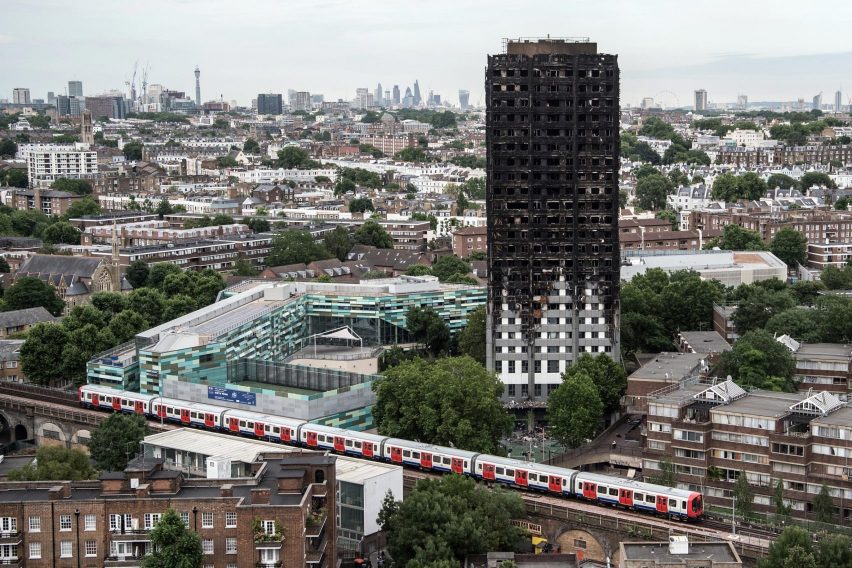
Renovation works at Grenfell Tower added "fuel" to fire, reveals leaked report
"Deficiencies" introduced during renovation works at Grenfell Tower contributed to fire deaths, according to a leaked report by fire safety experts.
Poorly installed fire barriers, gaps around window frames, and flammable cladding and insulation were introduced to the west London tower in renovation works by Studio E Architects before the fire, states the report.
The 210-page document prepared by fire experts BRE Global for the Metropolitan Police's investigation into the blaze, as seen by the Evening Standard, claims the fire's 71 deaths could have been avoided.
The report does not specify whether fault lies with the design or the installation of the features introduced during the renovation of the 24-storey 1970s residential tower. But it does claim that, had the postwar housing block remained unaltered, the fire would have been unlikely to spread.
Fire would have had "little opportunity" to spread in unaltered Grenfell Tower
The fire, which was started by a faulty fridge-freezer in a fourth-floor flat on 14 June 2017, instead broke through a window and spread rapidly up the building in a chimney-like effect attributed to its new cladding.
The report backs up this early speculation, citing "deficiencies" in the installation of the cladding system. It also suggests the tower would have "fully or partially" collapsed has the original structure been of lesser quality.
"Grenfell Tower, as originally built, appears to have been designed on the premise of providing very high levels of passive fire protection," states the report dated 31 January 2018.
"The original facade of Grenfell Tower, comprising exposed concrete and, given its age, likely timber or metal frame windows, would not have provided a medium for fire spread up the external surface," it continues.
"In BRE's opinion… there would have been little opportunity for a fire in a flat of Grenfell Tower to spread to any neighbouring flats."
Renovation works breached fire safety regulations
According to the Evening Standard, the report identifies five key breaches of building regulations that could have contributed to the Grenfell Tower deaths.
Cavity barriers were of "insufficient size specification" – these barriers, which should have prevented the spread of fire between different sections of the building spanned only half the gap between the old and new facade, rendering them ineffective. In addition, the report notes some of the barriers were installed "upside down" or "back to front".
Window frames were "significantly narrower than the gap between the concrete surfaces of the columns – these gaps were plugged with materials such as rigid foam insulation, which were unable to provide 30 minutes of fire resistance. The materials offered "a direct route for fire spread around the window frame into the cavity of the facade". The construction of the window instead gave "fuel" to the fire rather than offering a barrier.
"Combustible" insulation "provided a medium for fire spread up, across and within sections of the facade", the report claims. In addition, there were no markings to identify the manufacturer of the foam insulation used.
Aluminium composite cladding was found to have a "highly combustible" polyethylene core. This flammable core "appears to have provided a medium for fire spread up and across the facade".
"Absence of door closers" – this meant doors were left open when residents fled the fire, allowing it to spread to other parts of the building – including its single staircase.
The report also notes there was only space for "a single fire engine" at the base of the tower because of landscaping, which alongside poor access hampered efforts to fight the flames.
It states the 70-metre building should have been fitted with a wet rising main, a network of vertical pipes filled with water at all times.
The multi-million pound renovation and recladding of the building was carried out for the building's manager, the Kensington and Chelsea Tenant Management Organisation.
Following the fire, the UK government launched an emergency fire safety review of high-rise apartment buildings, ordering tests on up to 600 blocks found to be clad in similar aluminium-composite panels as Grenfell.
A mockup of the cladding system installed at Grenfell Tower during its renovation failed the government-ordered fire safety check. The test carried out by BRE was deemed an "absolute failure.
Cladding was stripped from many other blocks around the UK as a precaution, with residents in some instances forced to bear the brunt of the cost of replacement.
In August 2017, an interim report of a review of building regulations commissioned by the UK government found high-rise safety regulations "not fit for purpose".
Spatial research group Forensic Architecture is currently seeking footage of the Grenfell Tower fire to create a 3D video, which it hopes will help people understand how the disaster unfolded.